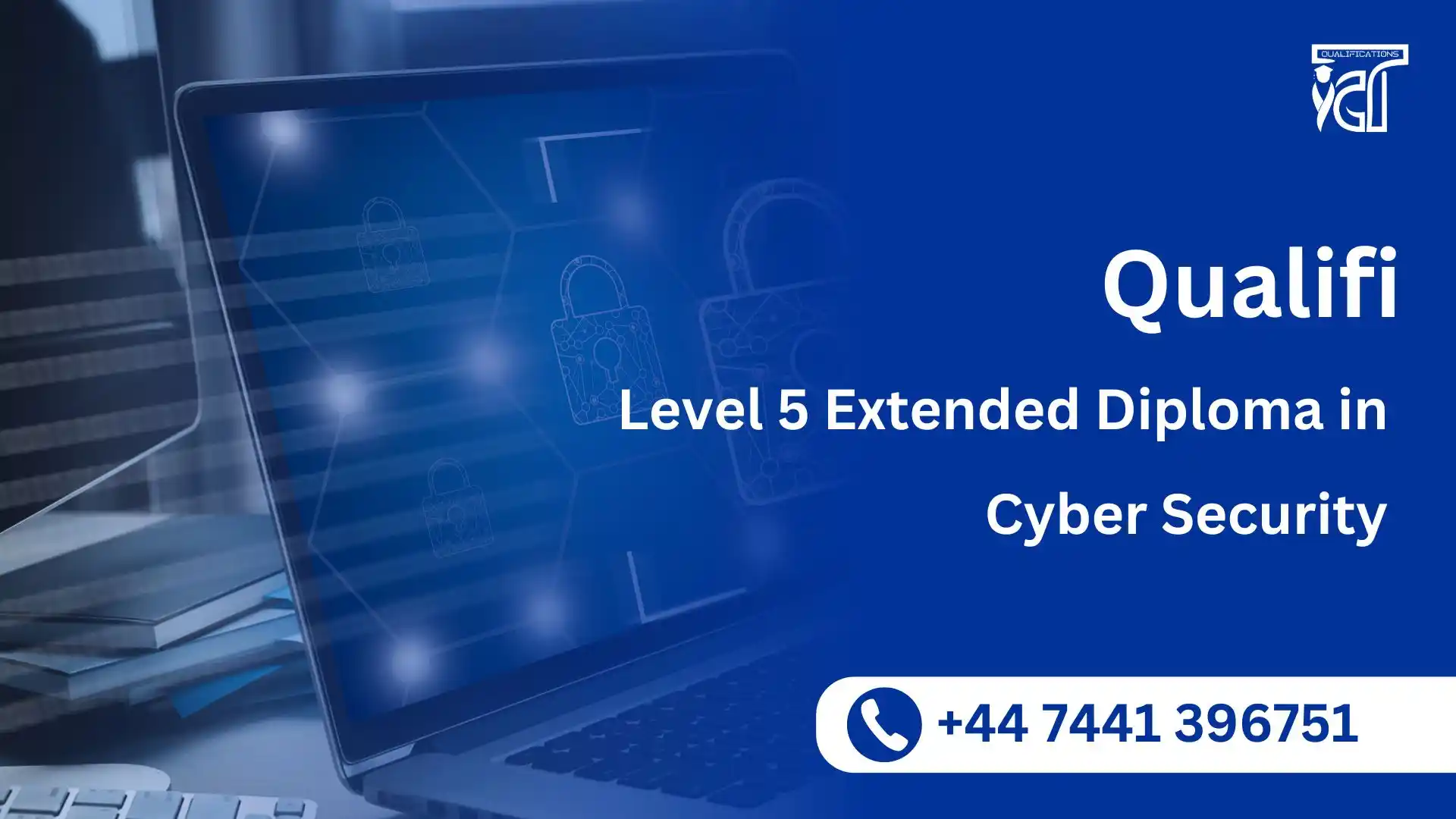The Qualifi Level 4 and Level 5 Combined Diploma in Cyber Security is designed to provide learners with an in-depth understanding of the critical principles, technologies, and practices that underpin the field of cyber security. This combined program equips individuals with the knowledge and practical skills needed to protect digital systems, networks, and data from an ever-growing range of cyber threats.
At Level 4, learners gain foundational knowledge in IT systems, networking concepts, information security, risk assessment, and cyber threat analysis. Moving to Level 5, the course delves into more advanced topics such as ethical hacking, digital forensics, cryptography, secure system design, and incident response management.
This diploma prepares individuals for a wide range of cyber security roles such as Cyber Security Analyst, Information Security Officer, IT Security Consultant, or Penetration Tester. It also serves as an excellent foundation for those intending to pursue further study or professional certifications in the cyber security domain.
Whether you are an IT professional seeking to specialise in security or a newcomer wanting to enter the high-demand field of cyber defence, this qualification offers the skills and expertise needed to succeed in protecting modern digital environments.
All 11 units are mandatory to receive 240 credits.
- Cyber Security Threat and Risk
- Network Security and Data Communications
- Database Security and Computer Programming
- Incident Response, Investigations and Forensics
- Security Strategy: Laws, Policies and Implementation
- Cyber Security Threats and Risk: Banking and Finance
- Cyber Wars
- Cryptography
- Digital Investigations and Forensics
- Communications and Incident Management
- Strategic Leadership
GLH (Guided Learning Hours) and TQT (Total Qualification Time) are terms commonly used in vocational qualifications to help define the amount of time a learner is expected to spend on their studies.
1. GLH (Guided Learning Hours)
GLH refers to the number of hours a learner spends being directly taught, supervised, or supported during their course. This includes the time spent in activities such as:
- Classroom instruction
- Practical workshops
- One-on-one tutoring or mentoring sessions
- Online learning sessions with tutor support
In other words, GLH represents the time that learners are actively engaged with their instructors or learning activities.
2. TQT (Total Qualification Time)
TQT represents the total amount of time a learner is expected to invest in completing a qualification, including:
- GLH (Guided Learning Hours): Time spent on direct learning, as explained above.
- Self-Directed Learning: This includes time spent on independent study, research, assignment completion, preparation for exams, and any other work the learner does outside of direct teaching hours.
TQT is a broader measure that includes all the time required to achieve the qualification. It helps learners and employers understand the overall commitment required for the qualification.
Key Differences Between GLH and TQT:
- GLH focuses on direct learning with guidance or supervision.
- TQT includes GLH as well as independent study time and other learning-related activities.
Example:
If a qualification has a TQT of 600 hours and a GLH of 250 hours, it means the learner should spend 250 hours in direct learning (classroom, online, or tutor-led sessions) and 350 hours on independent study or research.
Learning Outcomes of Qualifi Level 4 and Level 5 combined Diploma in Cyber Security:
Cyber Security Threat and Risk
- Understand complex business cyber security threats and risks
- Understand recent mega breaches and explain malware and ransomware attacks
- Understand how threats and malicious hackers are advancing and developing customised intrusion tools
Network Security and Data Communications
- Understand how computers and digital devices communicate with one another over a network
- Understand, at a strategic level, how computer networking, web applications and software can be exploited
- Understand methods of security prevention and systems hardening
- Understand key network security and systems resilience tools, terminology and models
Database Security and Computer Programming
- Understand the broad range of information security controls to protect databases
- Understand types of database categories of control
- Understand the underpinning concepts and models of cloud-based storage solutions
- Understand the relationship between computer programming and computer hacking
- Understand the ‘interpreted’ general-purpose programming language, Python
Incident Response, Investigations and Forensics
- Understand the role and composite parts of Incident Response as a business function and how CERTS operate
- Understand aligned task/task forces for Business Continuity, Disaster Recovery and Crisis Management
- Understand how major computer incidents are formally investigated
- Understand laws and guidance in relation to the conduct of planned and structured major incident investigations
Security Strategy: Laws, Policies and Implementation
- Understand the concept of strategy, strategic management, planning and buy-in in relation to cyber security
- Understand how legislation, formal industry standards, training and accreditations support cyber security
- Understand how to implement Plan, Do, Check and Act security and risk management policies
- Understand the future legal and technical environment and the impact on cyber security planning and digital risk management
- Understand how to plan and design a security audit for a cyber network
Cyber Security Threats and Risks: Banking and Finance
- Understand the threats and risks facing traditional and emerging financial services
- Understand the architectural structures of traditional and emerging financial markets
- Understand how payments systems connect to underpinning financial services architecture
- Understand how cryptocurrencies connect to underpinning financial services architecture
Cyber Wars
- Understand how nation states are potentially engaged in cyber defence and offensive capability strategy
- Understand the motivations and causes behind nationstate-linked cyber-attacks and breaches
- Understand how private sector industry has been targeted by potentially statesanctioned cyber-crime groups and/or armies
- Understand how CNI has been targeted by statebacked cyber-crime groups and/or armies
Cryptography
- Understand key cryptographic principles and modes
- Understand the standards, regulations and laws that apply to business and government organisations in relation to encryption
- Design an encryption plan and courses of action for a given organization
Digital Investigations and Forensics
- Understand the core principles of digital investigations
- Apply the types of tool that support professional digital investigations at a strategic level
- Plan for an investigations and forensics teams
- Understand the importance of safeguarding evidential integrity in digital investigations
Communications and Incident Management
- Understand the physical and human resources required to manage a major suspected cyber security incident
- Apply Business Continuity Management to major incident planning and response
- Understand how Disaster Recovery and Crisis Management are integrated into a suspected major cyber-enabled incident
- Evaluate the potential impact of NOT planning crisis communications and incident response
Strategic Leadership
- Understand the role senior leaders and strategic leadership
- Evaluate the management streams and performance monitoring mechanisms that relate to information security
- Understand how threat and risk identification and management is integrated into C-Suite considerations and governance
- Understand how data protection legislation impacts considerations of strategy-setting and strategic leadership
Course Benefits: Qualifi Level 4 and Level 5 Combined Diploma in Cyber Security
- Comprehensive Two-Level Learning
Acquire both essential (Level 4) and advanced (Level 5) cyber security knowledge in a single, streamlined program covering theory, tools, and real-world practices. - High-Demand Career Preparation
Gain skills that are highly sought after in industries worldwide, preparing you for roles such as Cyber Security Analyst, IT Security Specialist, Ethical Hacker, or Information Security Officer. - Hands-On, Practical Training
Learn through case studies, simulations, and practical exercises focused on real-world security challenges, including ethical hacking, penetration testing, and risk assessment. - Updated for Modern Threat Landscapes
Study the latest trends in cyber threats, vulnerabilities, malware, ransomware, and security technologies, ensuring your skills remain relevant in the evolving cyber environment. - Pathway to Higher Education and Certifications
Provides an excellent foundation for further studies or professional certifications such as CompTIA Security+, CISSP, CEH, or CISM. - Develop Critical Thinking and Problem-Solving Skills
Improve your analytical abilities to identify security risks, design defence strategies, and respond effectively to cyber incidents. - Flexible Study Options
Suitable for both full-time learners and working professionals with options for online, in-person, or blended learning delivery. - Diverse Career Opportunities Across Sectors
Opens doors to employment in industries such as finance, government, healthcare, defence, and private corporations where cyber security is mission-critical. - Globally Recognised Qualification
Earn a diploma respected by employers and educational institutions worldwide, enhancing your employability in the international job market. - Build Ethical and Professional Awareness
Understand the legal, ethical, and professional standards expected in the cyber security field, making you a responsible and informed practitioner.
Ideal Learner: Qualifi Level 4 and Level 5 Combined Diploma in Cyber Security
This course is designed for individuals who are passionate about technology, problem-solving, and protecting digital environments from cyber threats. It caters to a wide range of learners, including:
- Aspiring Cyber Security Professionals who want to start a career in cyber defence, ethical hacking, digital forensics, or information security management.
- IT Professionals and Network Engineers looking to expand their skillset by specialising in the field of cyber security.
- Graduates or Students in Computing, IT, or Engineering disciplines who want to gain a recognised qualification that bridges the gap between theory and practical security applications.
- Career Changers from non-IT backgrounds who are motivated to enter the rapidly growing and high-demand cyber security industry.
- Business Owners, Managers, or Entrepreneurs who want to understand how to protect their company’s data, networks, and digital assets from cyber threats.
- Freelancers or Consultants interested in offering cyber security services such as risk assessment, security audits, or penetration testing to clients.
- IT Enthusiasts with a keen interest in ethical hacking, cryptography, secure coding, and cyber risk management—even those without prior formal cyber security experience.
This qualification is especially suitable for motivated, analytical, and detail-oriented learners who enjoy problem-solving, critical thinking, and working with technology in dynamic and evolving environments.
Entry Requirements
Register Now
Qualification Process
Qualification Process for the Qualifi Level 4 and Level 5 combined Diploma in Cyber Security
- Self-Assessment:
Begin by evaluating your eligibility to ensure you meet the qualification requirements, including work experience, knowledge, and language proficiency. - Registration:
Complete your registration by submitting the required documents, including a scanned copy of a valid ID, and paying the registration fee. - Induction:
An assessor will conduct an induction to confirm your eligibility for the course and explain the evidence requirements. If you do not meet the criteria, your registration will be canceled, and the fee will be refunded. - Assignments & Evidence Submission:
Provide all assignments and the necessary evidence based on the assessment criteria outlined in the course. If you are unsure of the required evidence, consult with the assessor for guidance on the type and nature of evidence needed. - Feedback and Revision:
The assessor will review your submitted evidence and provide feedback. Evidence that meets the criteria will be marked as “Criteria Met,” while any gaps will be identified. You will be asked to revise and resubmit if needed. - Competence Evidence:
Submit final evidence demonstrating that all learning outcomes have been met. This evidence will be marked as “Criteria Met” by the assessor once it is satisfactory. - Internal Quality Assurance (IQA):
The Internal Quality Assurance Verifier (IQA) will review your evidence to ensure consistency, quality, and compliance with standards. - External Verification:
The IQA will submit your portfolio to Qualifies External Quality Assurance Verifiers (EQA) for final confirmation. The EQA may contact you directly to verify the authenticity of your evidence. - Certification:
Upon successful completion of all checks, Qualifi will issue your official certificate, confirming that you have attained the Qualifi Level 4 and Level 5 combined Diploma in Cyber Security







